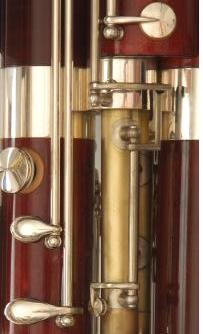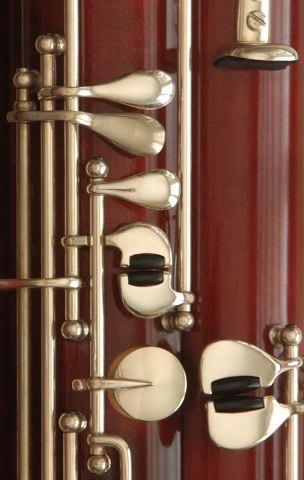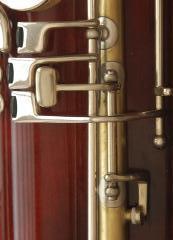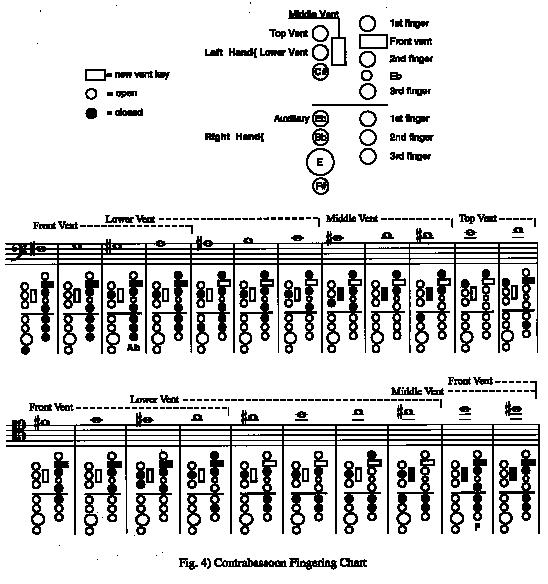Upgrade Article
Home.....Contra
Upgrade.....Updates.....Upgrade
Article.....Links.....Bio.....Contact
The Evolving Contra:
Simple Modifications For Major Improvement
by Allen Savedoff
A series of experiments were done to
improve the upper registers of the contrabassoon.These experiments led
to a modification that improves the sound of the entire instrument, as
well as additional modifications that improve the contrabassoon’s upper
registers. The changes described in this article can be made to existing
instruments. These modifications include replacing the long and short metal
pipes to improve the overall sound of the instrument and a key system using
two additional octave vents to improve the sound, pitch and response in
the upper registers.
In 1999 Arlen Fast gave a talk
in Los Angeles presenting his ideas on how to improve the upper registers
of the contrabassoon. Based on Fast's work and our knowledge of acoustics,
it was predicted that the desired improvements could be accomplished by
adding octave vents in new locations and by careful sizing of all the vents.
Since these new vents were expected to be located on the long metal pipe,
the pipe between the bocal and the tuning slide, a long pipe was needed
for experimentation.
Patterson
Hornworks, a french horn manufacturing company, made a long pipe
for this experimentation. The dimensions for the bore of this pipe were
derived from measurements taken from a number of contrabassoons. This hand-drawn,
seamed pipe was made of yellow brass. It improved the resonance, sound
focus and pitch definition in all registers of the instrument. Long pipes
were then made out of red brass and nickel. Of the three metals, the yellow
brass pipe produced the preferred sound. Next, a short pipe, the pipe between
the tuning slide and the wood, was made and installed; it yielded further
improvement to the sound, especially the pitch definition of the lowest
notes. These pipes, with the original key system, were used to record the
jazz-style contrabassoon album, Contradiction
(Capstone Records).
With these pipes, experimentation could
be done to determine what would improve the upper registers of the contrabassoon.
Theoretically, each note in the upper register should have its own vent
location and size. This system would be ideal acoustically but impractical
mechanically and technically. Therefore a system must be devised using
fewer vents, with each vent representing a compromise location and size
capable of producing multiple notes. The vent size to be used must be as
large as possible for increased resonance yet small enough to produce the
desired number of notes.
The experimentation was done on a
Mollenhauer
contrabassoon. Locations were selected on the new pipes and different sized
vents were tried to determine which vent size produced the best result
in each location. The usable range of notes was then determined. Our philosophy
in designing the new system was to get the most acoustical improvement
while keeping the key system and fingering technique as simple as possible.
The fingering technique was also to be kept similar to existing bassoon
and contrabassoon technique. Based on this philosophy, the optimum number,
location and size of each vent was chosen and a key system was devised.
This new key system uses four independent,
closed octave vents. These are: 1) a new “front” vent on the short pipe,
which is opened by a key placed below the left hand first finger key and
is operated with the same motion used for the half hole on bassoon;
 ................................
................................
Fig. 1) Location of the new front
Fig. 2) Left hand keys, showing the
vent on the short pipe.
the new front vent key.
2) the “lower” vent, which is opened by the first octave
key and only operates the re-sized vent on the long pipe. The previously
linked vent on the tuning slide is sealed and the linkage to the low E
key is disabled; 3) a new “middle” vent on the long pipe, which is opened
by a key in place of the auxiliary second octave key and is operated by
the left hand thumb and 4) the re-sized “upper” vent, which is opened by
the second octave key.
 Fig.
3) Left hand thumb keys, showing the
Fig.
3) Left hand thumb keys, showing the
new middle vent key and vent.
There are two changes musicians must
make in their fingering technique to use this system. Both are already
used in bassoon technique. One is the half hole motion for the left hand
first finger. The other is the new key for the left hand thumb (now operating
the same number of keys as bassoon, less the whisper key). It takes some
practice to make these fingering changes automatic, but it is not overly
difficult.
As can be seen in the accompanying
fingering chart, the basic fingerings are the same as in the traditional
system (with the exception of the first overblown D# and the second overblown
C#). Where vents are shown overlapping, both vents are opened. Consistent
with bassoon technique, the front vent is opened to produce the half hole
notes. The A sounds best using both the front and lower vent. The A#, B
and C are produced with the lower vent, unchanged from the traditional
fingering system. The middle vent is opened for C#, D and D#. Note, the
D# is fingered as in the lower octave. This fingering is sensitive to reed
strength. If the reed is too soft, the note can go flat. As with the traditional
fingering system, the E and F are produced with the top vent. The front
vent may be added to the F fingering to sharpen the pitch.
In the next octave, the F# and G fingerings
use the front vent. The top vent may be left open if desired without any
adverse effect, but having the thumb free is of great technical benefit.
The G# and A are produced with both the front and lower vent. As in the
traditional system, the Bb, B and C fingerings use the lower vent. The
C# is essentially the open F with resonance keys and is produced with both
the lower and middle vent. For D and D# both the front and middle
vents are opened.
This system allows performers complete
flexibility in choosing their preferred fingerings, including which vent(s)
to use. Different reed styles and strengths may require different fingerings
from those suggested in the chart.
These new pipes and keywork have been
added with positive results to Mollenhauer contrabassoons as old as 1986
and as new as 2002. The alterations required to implement this new system
are made on the metal pipes except for two holes drilled in the wood of
the “wing” joint to set the posts of the front vent key.
After having performed on this system
for a year, we have found that it is effective and usable. The improvement
in the sound of the contrabassoon is immediately apparent. The new vent
system has also clearly improved the resonance, pitch, response, evenness
and stability of the upper registers of the instrument. While this system
does require contrabassoonists to relearn their fingering technique, the
results are well worth the effort.
Addendum: Subsequent to
the presentation of this information at the IDRS
Convention in Greensboro, NC (June 2003), experimentation has been done
on the Fox contrabassoon. The long pipe can be added to the instrument,
improving the sound greatly as it does on the Mollenhauer. The middle
vent is also equally effective in improving the C#, D and D#. The lower
and upper vents can be re-sized for improved results.
However, the front vent cannot be placed
in the same position on the Fox as on the Mollenhauer due
to the difference in design of the tuning slide. To remedy this situation
the following choices are possible: 1) to modify the tuning slide to replicate
the Mollenhauer design (also adding the short pipe); 2) to find
an alternate location for the front vent or 3) retain the existing system.
Further experimentation is being done to decide which of these alternatives
is the most effective.
Acknowledgements: This project
was done in partnership with Tom Yaeh, a woodwind technician at
RDG,
Inc., whose expertise, work and patience was invaluable. Many thanks
to Jim Patterson for the design and creation of the pipes and to
Arlen
Fast and John Peterson for sharing their acoustical knowledge.
Photographs by Joe Meyer.
Allen Savedoff is a freelance bassoonist and contrabassoonist
in Los Angeles. He is a member of the Pacific
Symphony and Hollywood
Bowl Orchestras.

This article was published in The Double Reed, Volume 26, Number
3 (Fall 2003).
Previous Page..........Top
Home.....Contra
Upgrade.....Updates.....Upgrade
Article.....Links.....Bio.....Contact
© 2004 Allen Savedoff
 ................................
................................
 Fig.
3) Left hand thumb keys, showing the
Fig.
3) Left hand thumb keys, showing the
